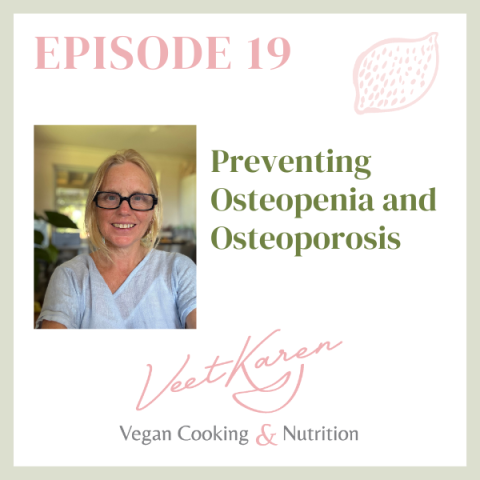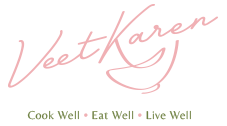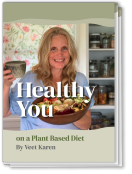
Episode 19
Preventing osteopenia and osteoporosis
I remember as a kid seeing someone hunched over at the shops and I asked my mum why they were like that and she told me it was a lack of calcium. I vowed to my young self that I would never get a hunched over back. Maybe that started off my cheese addiction. But these days we are now finding out that it is not milk that will help our bones grow nice and strong.
In this episode, episode #19 – golly gosh – how did I get to episode 19 already – I’m on fire!
I talk about osteopenia and osteoporosis and how to prevent it and also manage and potentially reverse it.
Listen Now
Show Notes and Links
Sign up for the list of phytoestrogen rich foods and a list of calcium rich foods
https://veets.us7.list-manage.com/subscribe?u=a12d59e5a4010fde408300393&id=d2285cd8c9
For a full list of calcium rich foods, sign up to Healthy You on the Plant Based Diet mailing list
https://www.veets.com.au/signup
For herb information go to episode https://www.veets.com.au/6
How to remove oxalates and phytic acid from food https://www.veets.com.au/9
Tahini biscuit recipe https://www.veets.com.au/blog/tahini-biscuits
For full show notes head on over to https://www.veets.com.au/19
Follow Veet on https://www.facebook.com/VeetKarenVegancookingandnutrition/
Introduction
As I was writing up my show notes, I noticed I am trying to sit up straighter and keep checking to see if I have a hunch at the back of my neck.
We all have heard about osteoporosis but now, what the heck fire is osteopenia.
It reminds me of when I first found out that there was such a thing as perimenopause, I thought to myself, isn’t menopause enough to deal with? Little did I know when I found out about that, I had already been through perimenopause and was on my way to enjoying menopause.
So fingers crossed I don’t have osteopenia right now.
But so far, I shouldn’t, as I don’t fit any of the criteria.
I will go through the difference between osteopenia and osteoporosis, and make some very sound suggestions on how to prevent both osteopenia and osteoporosis.
Osteopenia
Osteopenia is lower than normal BMD (bone mineral density).
It is not a disease.
It does increase the risk of developing osteoporosis.
It can be prevented, and it can be reversed.
Prevention of osteopenia .
The best time to start preventing osteopenia is the day you are born, and if that is not possible, then in your third decade of life.
However, it is definitely not too late to start.
You can start right now preventing osteopenia.
Symptoms of osteopenia
There aren’t any symptoms at all, so what this suggests is get onto it, do all the right things so you don’t get osteopenia.
Risk factors
Female
Family history
Over 50
If you had menopause before 45
Removal of ovaries before menopause
Not enough exercise – see ya – I’m out of here I’m going for a bike ride
Dietary calories being inadequate (big one so many young women restrict calories)
Smoking
Alcohol intake
Caffeine intake
Then there are certain diseases that can cause osteopenia
Anorexia
Bulimia
Cushing’s (condition where you have levels of cortisol)
Hyperparathyroidism
Hyperthyroidism
Inflammatory diseases like arthritis, lupus (an autoimmune disease where the cells attack the body, particularly skin and bones) and Crohn’s (inflammatory bowel disease).
When are people tested for osteopenia
If you are under 65 and have one or more of the risk factors I just mentioned you can get tested. Otherwise, testing occurs at 65.
Osteoporosis
Osteoporosis is a bone disease that can cause fractures and broken bones. It causes the body to bend over and can cause height loss, which is usually the first symptom and can be incredibly painful.
Osteoporosis can be prevented and possibly reversed with diligent care.
Osteoporosis can occur if you have certain illnesses like cystic fibrosis or inflammatory diseases as I mentioned for osteopenia
It can also be caused when going through menopause, due to a drop in oestrogen.
So important at this stage of life to be eating phytoestrogen rich foods.
You can sign up for the free menopause fact sheet to get a list of phytoestrogen rich foods. Click here.
Tests for osteoporosis and osteopenia
There are 2 tests
The T- score and the Z- score
The T-score tests your BMD against the average young healthy adult.
The Z-score tests your BMD against the average of someone of the same gender and age.
For the T score testing
A normal bone density reading is
1.0 to -1.0
Osteopenia
-1 to -2.5
Osteoporosis
-2.5 or above
Z score Results
-1.5 and above is typical for your age and gender group
Lower than -1.5 is an indication that there is a weakening of your bone density.
How to prevent osteopenia and osteoporosis
1. Exercise is a massive key in this puzzle.
Walking
Jumping
Running
Swimming
Bike riding
For 30 minutes daily.
Plus resistance exercise 3 times a week.
This means weight bearing exercise, like going to the gym.
2. Replace the following lifestyle/dietary choices with something else.
Smoking - (replace with exercise or dancing or a hobby)
Alcohol - (replace with drinks like lime soda or a hobby)
Caffeine - (replace with herbal teas, dandelion or mushroom blend drinks – or bancha tea)
Dairy - (replace with soy and nut cheeses)
3. Amp up the food to include.
a) More calcium.
You need 1000mg up to age 50 for women and men up to age 70 then 1300mg for all genders over 70.
b) More vitamin D.
c) K2 foods.
Calcium Sources
Contrary to popular belief, with milk it is not always easy for the body to absorb calcium from this source. Especially if you are lactose or dairy intolerant.
More absorbable calcium sources are:
Soy (100g) 350mg
Almonds (¼ cup) 97mg
Brazil nuts (¼ cup) 53mg
Tahini (2 tbsp) 130mg
Chickpeas or white beans (1/2 cup dry) 100g
Moringa (1 ½ tsp powder) 150mg
Moringa fresh 100g 185mg
Chia/flax (2 tbsp) 53mg
Amaranth & Teff cooked (1 cup) 350mg
Leafy greens (1 cup) 70mg
Seaweed (¼ cup) 31mg
Cruciferous veg (½ cup) 60-80mg
Figs (1 piece) 18mg
Orange 48-65mg
Blackcurrants (¼ cup) 2mg
1 cup quinoa 31.45mg
Olives 88mg
And herbs
All herbs have calcium at varying amounts.
I work on 10g of herb for 160mg calcium.
For this full list sign up for the Healthy You on a Plant Based Diet
So what that looks like for me on a typical day is
I allow 200mg of calcium from random foods that I have (because lots of foods have calcium in them but not high in calcium – which are the foods listed above)
200g tofu or tempeh 700mg (or amaranth and moringa on other days or chickpeas and moringa)
3 cups leafy greens 120mg
Seaweed ¼ cup 31mg
2 cups cruciferous veg 160mg
2 tbsp tahini 150mg
Almonds and Brazil nuts 65 mg
2 lots of herbs 350mg
Total 1450mg to 1575mg a day
It's easy if you are diligent at first, then it just becomes second nature.
Foods that can inhibit calcium are:
Alcohol
Caffeine
Foods containing oxalates and phytic acid, if they are not cooked properly (for how to cook them properly – head on over to episode #9
Vitamin D
You need vitamin D for the body to absorb calcium
You only need 5 - 10 ug of vitamin D a day.
If you are getting out in the sun, you don’t really need to worry about getting enough vitamin D, but plenty of people don’t go out in the sun.
You only need 10 to 30 minutes of sun a day to get enough vitamin D
Otherwise, you can eat foods fortified with vitamin D. However, that is not possible for me because I eat an organic diet and organic food is not fortified.
And a random is, tanning your mushrooms, yep, not your legs, your mushrooms. Put them in the sun for 15 minutes and they will absorb vitamin D. The vitamin D still remains when it's been cooked and it will last in the fridge for up to 7 days.
3 normal sized mushrooms will give you enough vitamin D for your daily dose.
So get tanning those mushrooms.
Vitamin K2
The recommended amount of K2 is usually around 60ug a day, however some sources are saying 120ug.
Fermented foods contain K2 in varying amounts.
1 serve of sauerkraut contains 10mg.
In Natto there is up to 500mg in just 2 tbsp.
With miso and tempeh there has not been enough research to show how much they contain.
I would just include them in your diet anyway.
So let’s all enjoy good bone health by following these fabulous tips.
And here is a really delicious biscuit recipe
Tahini biscuits
For full recipe click here
FCT
Dehydrating herbs.
If you have left over herbs you don’t think you are going to use, dry them out if you live in a dry climate, or whack them in the dehydrator if you live in a humid climate.
Best if putting in dehydrator to keep the stalk on, otherwise they will fly everywhere.
Dry or dehydrate them, then use them and store them in airtight containers to use at another time.
Better than throwing them out.
Thank you for listening
Hope you have a sensationally delicious day
Until next time
Bye.




